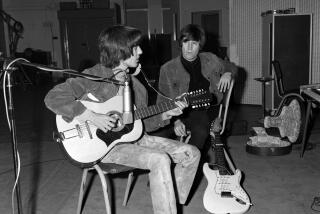Sale of the centuries
Which would you rather have? The Magna Carta or a page of Mozart manuscript? The foundation document of modern freedom and liberty or a sheet of paper on which one of the worldâs great artists has just captured the magic of a fleeting inspiration? What is so astonishing, and what never ceases to amaze me, is that these and so many other remarkable artifacts of our culture and history are available to the collector. For a price, of course.
The Mozart manuscript, a single page, sold in London last week for more than $200,000. The Magna Carta goes to auction at Sothebyâs on Dec. 18. Itâs also a single page, in this case a sheet of vellum made from sheepskin. The pre-sale auction estimate: $20 million to $30 million.
Now, Mozart is desirable and rare. Any Mozart manuscript is a direct link to one of the giants of human creativity. Itâs a way of reaching out across time, of almost touching the hand that wrote the golden notes, of watching the genius mind at work. That is why collectors gather manuscripts and why scholars pore over erasures and revisions. But Mozart, in his all too brief a life, was prolific. Many manuscripts and manuscript fragments survive. We see a handful at auction every year. So ... $200,000 is right.
Magna Carta. Another universe entirely. Simply, the most famous document in the world, imposed on the king of England by a group of English barons in the early 13th century, transforming forever the relationship between monarchs and those they rule. It is, in many ways, the birth certificate of freedom. The ancestor of our great charters of liberty -- the Declaration of Independence, the Constitution of the United States and the Bill of Rights. Add to that, this is the only version of the Magna Carta that will probably ever come on the market. Of the 17 Magna Cartas that survive from 1215, the year of Runnymede, to 1297, the year in which the words of the Magna Carta entered the statute books of England, 15 belong to public collections in Britain and the 16th is the cherished possession of the Australian people.
The sentences of the Magna Carta spin down the course of history, Latin sentences, mind you, written in a beautiful medieval chancery script, full of tiny curlicues, little grace notes, sentences that begin, âNulli vendemus, nulli negabimus ...â (To no one will we sell or deny or delay right or justice). Of such words and sentences were the fortifications against tyranny and despotism composed. From such words and sentences flowed, over time, others: âWe hold these Truths to be self-evident ... â; âWe the people of the United States, in Order to form a more perfect Union ... â; â ... that this nation, under God, shall have a new birth of freedom.â
Does this begin to explain $20 million to $30 million? Last year, the papers of the Rev. Martin Luther King Jr. sold to the city of Atlanta for $32 million. Seven and a half years ago, a first printing of the Declaration of Independence sold for $8.1 million. Those are comparables of a sort. But the Magna Carta is incomparable. The Magna Carta is a lamp in the darkness, a glowing talisman of our human condition, a sacred icon of our human history.
More to Read
The biggest entertainment stories
Get our big stories about Hollywood, film, television, music, arts, culture and more right in your inbox as soon as they publish.
You may occasionally receive promotional content from the Los Angeles Times.










